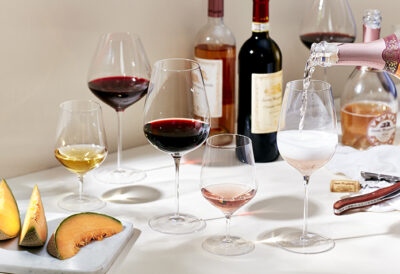Why are wine glasses so big? The size of wine glasses is a topic that has intrigued wine enthusiasts and curious minds alike. Wine, often celebrated for its nuanced flavors and aromas, seems to be served in an array of glass sizes, from petite and delicate to generously oversized.
The rationale behind the size of wine glasses goes beyond mere aesthetics. It is intricately tied to enhancing the wine-drinking experience, accentuating the unique qualities of different wine varieties, and even rooted in cultural traditions. In this exploration, we delve into the fascinating world of wine glasses and the reasons behind their varying sizes.
Why do wine glasses vary in size?
Wine glasses come in various sizes and shapes for several reasons, each of which contributes to the overall wine-drinking experience. The key factors that influence the design and size of wine glasses include:
Wine Type: Different types of wine have distinct characteristics, and the size and shape of a wine glass can enhance or diminish these qualities. For example:
-
- Red wine glasses: These are typically larger and have a wider bowl to allow for aeration, which helps volatile compounds in red wines to release their aromas and flavors. The larger surface area also allows for better contact with oxygen, which can soften tannins in red wines.
- White wine glasses: These are generally narrower with a smaller bowl to help preserve the delicate aromas and maintain cooler temperatures for white wines. The narrower shape also directs the wine to the front of the mouth, where you can better appreciate its acidity.
Aroma Concentration: The shape of the wine glass can influence how the wine’s aromas are concentrated and directed towards your nose. A larger bowl with a tapered opening can capture and concentrate the wine’s aromas, enhancing your ability to smell and savor them.
Aeration and Oxidation: Some wines benefit from exposure to air, which can soften harsh tannins and open up complex flavors. Larger wine glasses provide more surface area for the wine to interact with oxygen, aiding in aeration and oxidation. This is particularly important for young, full-bodied red wines.
Temperature Control: Wine glasses are designed to help maintain the ideal serving temperature for specific wine types. White wine glasses have narrower bowls to keep the wine cooler, while red wine glasses have larger bowls to allow red wines to reach their optimal temperature.
Presentation and Tradition: Wine glasses are also chosen for their aesthetic appeal and historical significance. Different wine-producing regions have their own traditions and glassware preferences, which have been developed over centuries. These traditions often reflect the local wine culture and the characteristics of the wines produced in the area.
Personal Preference: Finally, personal preference plays a role. Some individuals may have specific preferences for the size and shape of their wine glasses based on their own sensory experiences and tastes.
Does the size of a wine glass affect wine taste?
Yes, the size and shape of a wine glass can have an impact on the perception of a wine’s taste and aroma. Here are a few ways in which the size of a wine glass can influence the wine-drinking experience:
- Aroma Concentration: A larger bowl allows for more space to swirl the wine, which can increase the surface area exposed to air. This promotes aeration and helps release the wine’s aromas. Aroma concentration can be more pronounced in larger glasses, enhancing the overall sensory experience.
- Aeration: A wider bowl provides more room for the wine to come into contact with oxygen, facilitating aeration. This can lead to the opening up of the wine, allowing it to “breathe” and potentially improve its flavor profile.
- Temperature Regulation: The size of a glass can affect how quickly a wine warms up or cools down. A smaller glass with a narrower opening can help maintain the wine’s temperature, whereas a larger glass may allow it to warm up more quickly.
- Surface Area: The surface area of the wine in the glass can influence how quickly it evaporates, which in turn affects the release of aromas. A wider glass provides more surface area, which can lead to a more pronounced aromatic experience.
- Balance and Proportion: The size and shape of a glass can influence how the wine is distributed across the palate. For example, a glass with a narrower rim can focus the wine to specific areas of the tongue, potentially emphasizing different flavor components.
- Personal Perception: Different individuals may have varying experiences based on their own sensory perceptions and preferences. Some people might prefer the characteristics brought out by a particular glass, while others may have a different preference.
Also, while the size and shape of a glass can influence the wine-drinking experience, there is no one-size-fits-all answer. Different types of wine may benefit from different styles of glassware. For instance, red wines generally benefit from glasses with a larger bowl to allow for aeration, while white wines may be better served in glasses with a more narrow bowl to help preserve their cooler temperature.
Ultimately, the choice of glassware can enhance the overall enjoyment of the wine, but it’s just one of many factors that contribute to the tasting experience. The quality of the wine, its age, the serving temperature, and the environment in which it’s consumed all play crucial roles as well.
How do wine glass shapes impact wine enjoyment?
Wine glass shapes can significantly impact the enjoyment of wine, as they play a crucial role in how you experience the wine’s aroma and flavor. The key factors affected by wine glass shape include:
- Aroma Concentration: The shape of the glass can either concentrate or disperse the wine’s aroma. A glass with a narrow opening, such as a tulip-shaped or Bordeaux glass, concentrates the aromas, making it easier to detect the wine’s nuances. This is particularly important for wines with complex aromatic profiles, like red Bordeaux or Pinot Noir. In contrast, wider glasses, such as those used for white wines or Burgundy, allow the aromas to disperse more, which can be beneficial for wines with delicate or subtle aromas.
- Aeration: Aeration is the process of exposing the wine to oxygen, which can help open up and release its aromas and flavors. Different glass shapes provide varying levels of aeration. Glasses with a larger bowl and wider opening, like those designed for red wines, allow for more aeration. This is advantageous for young, tannic red wines that benefit from oxygen exposure to soften and develop their flavors. Conversely, glasses with a smaller bowl, like those for white wines or sparkling wines, minimize aeration to preserve the wine’s freshness.
- Temperature Maintenance: The size and shape of the glass can also influence the temperature of the wine. Smaller glasses keep wine cooler for longer, which is ideal for serving white wines or sparkling wines at their recommended serving temperatures. Larger glasses allow red wines to slightly warm up, enhancing their aromas and flavors as they reach their optimal drinking temperature.
- Wine Presentation: Wine glasses are designed not only for functionality but also for aesthetics. The shape and design of the glass can enhance the visual appeal of the wine, making it more enjoyable on a sensory level. For example, sparkling wines are traditionally served in flutes to showcase their effervescence, while long-stemmed glasses for red wines are elegant and practical for swirling.
- Wine-Specific Glasses: Many wine enthusiasts and professionals use specialized glasses for specific grape varieties or wine styles. For instance, there are glasses designed for Cabernet Sauvignon, Chardonnay, Pinot Noir, and more. These glasses are engineered to highlight the unique characteristics of the wine they are intended for.
Why are some wine glasses so large compared to others?
Wine glasses come in various sizes and shapes, and the choice of glassware depends on several factors, including the type of wine being served and personal preferences. Here are some reasons why wine glasses can vary in size:
- Aeration and aroma: One of the primary reasons for varying wine glass sizes is to enhance the aeration of the wine and release its aromas. Red wines, for example, typically have larger bowls to allow more contact with oxygen, which can help soften tannins and develop the wine’s bouquet. White wine glasses often have smaller bowls to preserve the wine’s delicate aromas.
- Wine type: Different types of wine glasses are designed for specific wine varietals. For example, Bordeaux glasses have a tall, broad bowl to accommodate the complexity and aroma of Bordeaux wines, while Burgundy glasses have a wider bowl to enhance the aromas and flavors of Pinot Noir.
- Taste and temperature: The size and shape of a wine glass can influence the way you perceive the taste and temperature of the wine. A larger bowl allows for swirling, which can help release more aromas and flavors. Moreover, the shape of the glass can direct the wine to different parts of the palate, emphasizing certain characteristics.
- Aesthetic and tradition: Wine glasses also vary in size for aesthetic reasons and to align with traditional practices. Some stemware designs are iconic and have been used for centuries, adding to the overall wine-drinking experience and the sense of occasion.
- Personal preference: Ultimately, the choice of wine glass size can come down to personal preference. Some people prefer larger glasses because they can hold more wine and allow for a more generous pour, while others prefer smaller glasses for more controlled tasting and sipping.
Do different types of wine require specific glass sizes?
Yes, different types of wine often benefit from specific glass sizes and shapes. The design of wine glasses has evolved over centuries to enhance the characteristics of different wine varietals. Here are some general guidelines for matching wine types with appropriate glassware:
- Red Wine Glasses:
-
- Bordeaux Glass: This glass has a tall, broad bowl and is suitable for Bordeaux and other full-bodied red wines like Cabernet Sauvignon and Merlot. The large bowl allows for aeration, which can soften tannins and develop complex aromas.
- Burgundy Glass: Designed for wines like Pinot Noir and Burgundy, this glass has a wider bowl than Bordeaux glasses. The broader bowl helps to enhance the delicate aromas and flavors of these lighter red wines.
- White Wine Glasses:
-
- Chardonnay Glass: Chardonnay glasses have a wider bowl and are designed for full-bodied white wines like Chardonnay. The larger bowl allows these wines to breathe and develop their rich flavors.
- Sauvignon Blanc Glass: This glass has a narrower bowl than Chardonnay glasses and is ideal for wines like Sauvignon Blanc. The shape focuses the wine’s aromas, emphasizing its crispness and acidity.
- Sparkling Wine Glasses:
-
- Flute: The classic choice for Champagne and other sparkling wines, the flute’s narrow shape helps to preserve the bubbles and concentrate the wine’s aromas.
- Tulip-Shaped Glass: Some prefer tulip-shaped glasses for sparkling wines as they offer a bit more space for aromas to develop while still maintaining bubble retention.
- Dessert Wine Glasses:
-
- Small Glasses: Dessert wines, such as Port or Sauternes, are typically served in smaller glasses to highlight their intense flavors and aromas.
- Universal Wine Glasses:
-
- Some wine enthusiasts opt for universal glasses that can work reasonably well with a variety of wine types. These glasses have a shape that strikes a balance between the features of red and white wine glasses.
While matching specific wine types with their designated glasses can enhance the tasting experience, it’s essential to remember that personal preference plays a role as well. You can certainly enjoy wine in any glass that you find pleasing, but using the right glass can help maximize the wine’s potential by enhancing its aromas and flavors.
Does the size of a wine glass affect wine aromas?
Yes, the size and shape of a wine glass can significantly affect the perception of wine aromas. Wine glasses are designed with specific bowl shapes and sizes to enhance the aromatic experience of different wine varietals.
Here’s how the size of a wine glass can influence wine aromas:
- Aroma Concentration: A smaller wine glass with a narrow bowl will concentrate the wine’s aromas, making them more pronounced and focused. This can be beneficial for wines with subtle or delicate aromas, such as many white wines. When the bowl is narrower, it directs the aromas more directly toward the nose, allowing you to appreciate the wine’s nuances.
- Aeration: Conversely, a larger wine glass with a wider bowl provides more surface area for the wine to come into contact with oxygen. This aeration can help open up the wine, releasing its aromas and allowing them to evolve and become more expressive. This is particularly useful for complex red wines like Bordeaux or Cabernet Sauvignon.
- Temperature Control: The size of the glass also affects the rate at which the wine’s temperature changes. Smaller glasses tend to keep the wine cooler longer, which can be beneficial for white wines that are best served chilled. Larger glasses, on the other hand, can help slightly warm a red wine that might benefit from being served a touch above cellar temperature.
- Aroma Perception: The shape of the glass can direct the wine’s aromas to different parts of the nose and palate, influencing how you perceive the wine. For example, a tulip-shaped glass concentrates aromas toward the nose, enhancing the olfactory experience, while a wider bowl can direct wine to various parts of the palate, emphasizing different flavor components.
Conclusion
If you need answers to why are wine glasses so big, then we have got you covered. Wine glasses are often designed with larger bowls to enhance the wine-drinking experience. The size allows for better aeration of the wine, which can release its aromatic compounds and flavors, making it more enjoyable to taste and appreciate.
Additionally, larger glasses provide ample space for swirling the wine, further aiding in aeration and the evaluation of its characteristics. In essence, the size of wine glasses serves to optimize the sensory aspects of wine consumption, making it a more pleasurable and informative experience for enthusiasts and connoisseurs alike.




